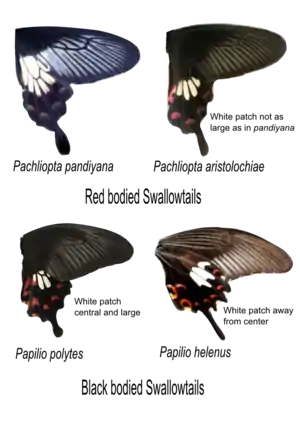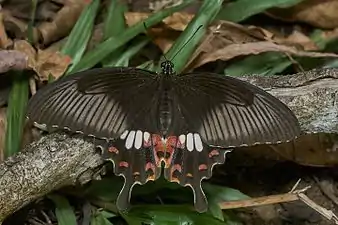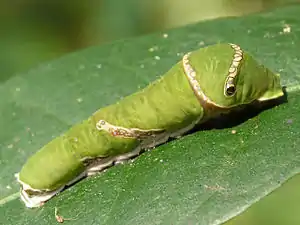Papilio polytes
Papilio polytes, the common Mormon,[1][2] is a common species of swallowtail butterfly widely distributed across Asia.[1][2]
| Common Mormon | |
|---|---|
 | |
| Mating pair with female in form stichius | |
| Scientific classification | |
| Kingdom: | |
| Phylum: | |
| Class: | |
| Order: | |
| Family: | |
| Genus: | |
| Species: | P. polytes |
| Binomial name | |
| Papilio polytes | |
| Subspecies | |
|
many, see text | |
This butterfly is known for the mimicry displayed by the numerous forms of its females which mimic inedible red-bodied swallowtails, such as the common rose and the crimson rose.
Names
The common name is an allusion to the polygamy formerly practiced by members of the Mormon sect according to Harish Gaonkar, of the Natural History Museum in London:[3]
... the origins of giving common English names to organisms, particularly butterflies for tropical species started in India around the mid 19th century ... The naming of Mormons evolved slowly. I think the first to get such a name was the Common Mormon (Papilio polytes), because it had three different females, a fact that could only have been observed in the field, and this they did in India. The name obviously reflected the ... Mormon sect in America, which as we know, practiced polygamy.
The scientific name is constructed from the Latin word for butterfly, papilio, and the Greek word for many, poly.[4]
Range
Pakistan, India, Bangladesh, Nepal, Sri Lanka, Maldives, Myanmar, Thailand, southern and western China (including Hainan and Guangdong provinces), Taiwan, Hong Kong, Japan (Ryukyu Islands), Vietnam, Laos, Cambodia, Andamans, Nicobars, eastern and Peninsular Malaysia, Brunei, Indonesia (except Moluccas and Irian Jaya), Philippines, and Northern Marianas (Saipan).[1][2]
Status
Very common. Not threatened.[5]
Description

Jet black butterfly with row of white spots along the middle part of hindwing. 90–100 mm.[6][7]
Male
The male has one morph only. It is a dark-coloured swallow-tailed butterfly. The upper forewing has a series of white spots decreasing in size towards the apex. The upper hindwing has a complete discal band of elongated white spots. It may or may not have marginal red crescents. The males are generally smaller in size than the females but not always. Both male and all forms of the female of P. polytes can vary considerably in size depending on climatic region.[6]
 Male, UN
Male, UN Male, UP
Male, UP
Female
The female of the common Mormon is polymorphic. In the Indian Subcontinent, it has several forms or morphs. These are as follows:[6]
Form cyrus
This form is similar to the male, differing in that it always has strongly marked red crescents. It is the least common of the three forms. It is normally abundant where the common rose or crimson rose do not occur, such as in Himachal Pradesh around Shimla; although a few specimens of form romulus have also been caught alongside.[6]
Form stichius
This female form of the common Mormon mimics the common rose very closely. This is the commonest form wherever the common rose flies.[6]
Form romulus
This female form mimics the crimson rose and is common over its range. It is not such a close mimic as the previous form being duller than its model. It is easy to differentiate the mimics from models by the colour of their body—the models are red-bodied and the mimics are black-bodied.[6]
_female_underside.jpg.webp) Female form cyrus UN
Female form cyrus UN Female form stichius UP
Female form stichius UP_female_underside.jpg.webp) Female form stichius UN
Female form stichius UN Female form romulus UP
Female form romulus UP_female_underside.jpg.webp) Female form romulus UN
Female form romulus UN_female_form_romulus_in_flight_Babai_bridge.jpg.webp) Female form romulus in flight UP
Female form romulus in flight UP
Gynandromorphs
This species has considerable genetic variability and is known to produce gynandromorphs, genetic aberrations which are part male and part female.
Taxonomy
Papilio polytes is the nominal member of the polytes species group. The clade members are:
- Papilio polytes Linnaeus, 1758
- Papilio ambrax Boisduval, 1832
- Papilio phestus Guérin-Méneville, 1830
The subspecies of Papilio polytes listed alphabetically are:[1][2]
- P. p. alcindor Oberthür, 1879 – Buton, Salayer & Sulawesi
- P. p. alphenor Cramer, [1776] – Philippines
- P. p. javanus Felder, 1862 – Bali, Bangka, Biliton, Java & southern Sumatra
- P. p. latreilloides Yoshino, 2018 – N. Yunnan, N.E. Vietnam
- P. p. ledebouria Eschscholtz, 1821 – Philippines
- P. p. messius Fruhstorfer, 1909 – Lombok
- P. p. nicanor C. & R. Felder, 1865 – Bachan, Halmahera, Morotai, Obi & Ternate
- P. p. nikobarus C. Felder, 1862 – Nicobar Islands
- P. p. pasikrates Fruhstorfer, 1908 – Philippines (Batanes) & Taiwan
- P. p. perversus Rothschild, 1895 – Sangir & Talaud
- P. p. polycritos Fruhstorfer, 1902 – Banggai, Sula Is.
- P. p. polytes Linnaeus, 1758 – Indo-China, China & Taiwan
- P. p. romulus Cramer, [1775] – Nepal, India, Burma & Sri Lanka
- P. p. rubidimacula Talbot, 1932 – W.Yunnan
- P. p. sakiboso Yoshino, 2018 – W. Sichuan
- P. p. sotira Jordan, 1909 – Sumbawa
- P. p. steffi (Page & Treadaway, 2003) – Bongao, Sibutu & Tawitawi in the Philippines
- P. p. stichioides Evans, 1927 – South Andamans
- P. p. theseus Cramer, [1777] – Sumatra & Borneo
- P. p. timorensis C. & R. Felder, 1864 – Babar Islands, Wetar, Leti, & possibly Timor
- P. p. tucanus Jordan, 1909 – Tukangbesi Islands
- P. p. vigellius Fruhstorfer, 1909 – Bawean
Mimicry

In India, this butterfly is considered as the classic example of Batesian mimicry in which edible species resemble unpalatable butterflies in order to escape being eaten by predators.
The populations of the mimicking morphs of the common Mormon are much smaller than that of their models - the common or crimson rose. This allows first time predators a much greater chance of preying upon the unpalatable model in the first instance and thus learning of their inedibility.
Larger populations of mimics could result in the edible common Mormon mimics being sampled the first time by predators. If this should happen, the predator may not realise that butterflies of that colour and pattern are protected by the poisons they ingest; thus dramatically reducing the effectiveness of this scheme of protection.
In Sulawesi, although the common rose is abundant, the common Mormon female morph which is found there, mimics a completely different butterfly, Atrophaneura polyphontes.
A single gene, doublesex, regulates the complex wing patterns, colors and structures required for this mimicry.[8][9][10]
Habitat
The common Mormon prefers lightly wooded country, but is present everywhere and high up into the hills. It is a regular visitor to gardens, being especially abundant in orchards of its food plants—oranges and limes. It is most common in the monsoon and post-monsoon months.
Habits

The common Mormon is fond of visiting flowers and its long proboscis permits it to feed from flowers having long corollar tubes. It is particularly fond of Lantana, Jatropha, Ixora, and Mussaenda in city gardens. In the forests, the common Mormon remains low keeping within ten feet off the floor and its prefer to visit Asystasia, Peristrophe, and Jasminum for nectar.
The male common Mormon is a very common visitor to gardens where he will be seen hovering over flowers when the sun is shining. It is a restless insect, zigzagging fast and straight close to the ground, settling down only when it halts to feed.
The mimic female Mormons, stichius and romulus are very convincing mimics due to their habits, especially the flight patterns, being very similar to those of the rose models. However, lacking the protection of inedibility, they tend to be more easily disturbed than the roses and fly off erratically .
Only the males take part in mud puddling, usually in cool shaded spots rather than in open areas. They have been known to collect on saline soils to extract minerals.[11]
Both sexes bask in the sun on shrubs close to the ground. They hold their wings flat against the substratum. The forewing is lowered to cover part of the hindwing and is a typical stance of the common Mormon.
Common Mormons spend the night settled on vegetation with their wings held open, usually quite close to the ground.
Life cycle
 Mating pair with the female displaying romulus form on top
Mating pair with the female displaying romulus form on top Mating pair with the female displaying stichius form on top
Mating pair with the female displaying stichius form on top Common Mormon egg
Common Mormon egg_catapillars.jpg.webp) Different stage instars
Different stage instars fifth instar
fifth instar pre-pupa caterpillar
pre-pupa caterpillar Pupa
Pupa
The females perch on an exposed branch with wings open or closed. They are courted by the males who approach from behind and slowly and elegantly settle into position.
Eggs
The eggs are laid singly on top of the leaves. They are round and yellow to light-orange in colour.[6]
Caterpillar
The first few instars of the caterpillar closely resemble those of the lime butterfly.[6]
The later instars become dark green in colour. There is a transverse black band with an eye-spot on each side on the 4th and 5th segments. This band, being darker and brighter than that of the lime butterfly caterpillar, is the key distinction between the two.[6]
The common Mormon caterpillar also has a black and white oblique band on the 8th and 9th segments, making it resemble that of the blue Mormon. The deep red osmeterium and yellowish-brown head help distinguish it from the blue Mormon caterpillar which has a greenish head.[6]
Common Mormon caterpillars are heavily parasitised by chalcid wasps, with over a hundred tiny wasps eventually emerging from each Mormon pupa.[6]
Pupa
The pupa is located on underside of leaves and twigs. The pupa is light green and unmarked. It has two projections to the front on its head and also one on its thorax. It closely resembles the lime butterfly caterpillar but can be distinguished by:
- the projections on the head which have a deeper indentation between them.
- the abdomen which protrudes to a small point on each side.[6]
Food plants
The larvae breed on various species of family Rutaceae including:
- Aegle marmelos or bael
- Atalantia racemosa[12]
- Citrus spp. (C. aurantifolia, C. grandis, C. limon, C. medica, C. sinensis)
- Glycosmis arborea
- Murraya koenigii – curry leaf
- Murraya paniculata
References
- Varshney, R.K.; Smetacek, Peter (2015). A Synoptic Catalogue of the Butterflies of India. New Delhi: Butterfly Research Centre, Bhimtal & Indinov Publishing, New Delhi. p. 7. doi:10.13140/RG.2.1.3966.2164. ISBN 978-81-929826-4-9.
- Savela, Markku. "Papilio polytes Linnaeus, 1758". Lepidoptera and Some Other Life Forms. Retrieved July 3, 2018.
- Asian Mormon Butterflies Archived 2007-09-28 at the Wayback Machine Accessed November 2006
- Papilio polytes PDF Archived September 1, 2006, at the Wayback Machine
- Collins, N. Mark; Morris, Michael G. (1985). Threatened Swallowtail Butterflies of the World: The IUCN Red Data Book. Gland & Cambridge: IUCN. ISBN 978-2-88032-603-6 – via Biodiversity Heritage Library.
-
 One or more of the preceding sentences incorporates text from a work now in the public domain: Bingham, C.T. (1907). The Fauna of British India, Including Ceylon and Burma. II (1st ed.). London: Taylor and Francis, Ltd. pp. 61–63.
One or more of the preceding sentences incorporates text from a work now in the public domain: Bingham, C.T. (1907). The Fauna of British India, Including Ceylon and Burma. II (1st ed.). London: Taylor and Francis, Ltd. pp. 61–63.
- Moore, Frederic (1901–1903). Lepidoptera Indica. Vol. V. London: Lovell Reeve and Co. pp. 223–232.
- "A single gene called doublesex controls wing mimicry in butterflies". UChicago News. 2014-03-07. Retrieved 2017-11-03.
- "Single gene controls butterfly wing pattern". www.abc.net.au. 2014-03-06. Retrieved 2017-11-03.
- Kunte, K.; Zhang, W.; Tenger-Trolander, A.; Palmer, D. H.; Martin, A.; Reed, R. D.; Mullen, S. P.; Kronforst, M. R. (2014-03-05). "doublesex is a mimicry supergene". Nature. 507 (7491): 229–32. doi:10.1038/nature13112. PMID 24598547. S2CID 4448793.
- Pola, M., García-París, M. (2005). Marine puddling in Papilio polytes (Lepidoptera Papilionidae). Florida Entomologist 88: 211-213.
- Kunte, K. (2006). Additions to known larval host plants of Indian butterflies. Journal of the Bombay Natural History Society 103(1):119-120.
Further reading
- Evans, W.H. (1932). The Identification of Indian Butterflies (2nd ed.). Mumbai, India: Bombay Natural History Society.
- Gay, Thomas; Kehimkar, Isaac David; Punetha, Jagdish Chandra (1992). Common Butterflies of India. Nature Guides. Bombay, India: World Wide Fund for Nature-India by Oxford University Press. ISBN 978-0195631647.
- Haribal, Meena (1992). The Butterflies of Sikkim Himalaya and Their Natural History. Gangtok, Sikkim, India: Sikkim Nature Conservation Foundation.
- Kunte, Krushnamegh (2000). Butterflies of Peninsular India. India, A Lifescape. Hyderabad, India: Universities Press. ISBN 978-8173713545.
- Wynter-Blyth, Mark Alexander (1957). Butterflies of the Indian Region. Bombay, India: Bombay Natural History Society. ISBN 978-8170192329.
External links
| Wikispecies has information related to Papilio polytes. |
| Wikisource has original text related to this article: |
 Media related to Papilio polytes at Wikimedia Commons
Media related to Papilio polytes at Wikimedia Commons- Butterflies of Sri Lanka
- Mimicry, Nagoya University
- Photos & videos of step by step of common Mormon